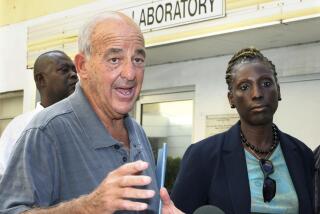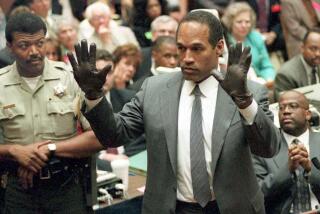Death on the Small Screen Puts Spotlight on TV Ethics
- Share via
NEW YORK — When principals at “60 Minutes” learned two weeks ago that Dr. Jack Kevorkian was offering them a tape of him killing a patient, their first reaction was skepticism.
Mike Wallace, who had never met Kevorkian, viewed him as “kind of shopworn and a publicity seeker.” And Don Hewitt, the show’s executive producer, “had no interest, none whatsoever,” recalled Wallace.
Indeed, Hewitt had long opposed televising executions if they ever were open to camera crews, certain the pictures of death would be too gruesome for a TV audience. Why should Kevorkian’s tape be any more palatable?
Then the tape arrived two weeks ago at “60 Minutes” headquarters here. Eventually, Hewitt said, “The decision to put it on was not a difficult one.”
The tape showed that Kevorkian had taken his right-to-death campaign to a new level--from assisted suicide to euthanasia, “death triggered directly by a doctor,” as Wallace eventually described it on the air. Indeed, it showed Kevorkian personally injecting a lethal dose of drugs into the right hand of Thomas Youk, 52, a victim of paralyzing Lou Gehrig’s disease.
“I looked at it,” said Hewitt, “and I saw a man peacefully shedding an unbearable life.”
So once Hewitt and Wallace assured themselves that the dying man and his family were willing participants--and had not been coerced by Michigan’s infamous “Dr. Death’--it was full speed ahead.
But even as Sunday’s broadcast quickly prompted yet another investigation of Kevorkian, and renewed nationwide discussion of euthanasia, it also has set off debate on the ethics of “60 Minutes,” which has been accused of everything from bad taste to a ratings ploy--because the segment aired during the “sweeps” period, when ratings translate directly into advertising dollars.
And because this was a first for television, the debate is likely to impact how TV does or doesn’t address the issue in the future. On Tuesday, the “60 Minutes” mainstays defended their actions by telling exactly how the tape came to their attention, and by detailing the decision-making process that followed.
“Of course, [Kevorkian] was using ’60 Minutes,’ ” Wallace said with the bluntness that has helped make the CBS show a ratings leader for three decades. “Presidential candidates use ’60 Minutes.’ Civil rights groups use ’60 Minutes.’ There’s an exchange of currency: They give us fascinating stories and we deliver to them a big audience.”
The tip about the Kevorkian tape had come in on Nov. 10, in a typically circuitous manner. The intermediary was Charles R. Eisendrath, director of the University of Michigan’s Journalism Fellows program, which counts Wallace among its financial supporters.
Wallace Called a ‘Hero’ to Kevorkian
Eisendrath said he got a call from a former student, Jack Lessenberry, now a freelance writer in the area, who had gained the trust of the controversial physician.
“[Lessenberry] called and said, ‘I’m sitting here with Jack Kevorkian. Mike Wallace is one of Dr. Kevorkian’s heroes and he thinks Mike might be interested [in a story]’ ” Eisendrath recalled. “Then he put Kevorkian on the line.”
Eisendrath said that after hearing about the tapes of September counseling sessions with a dying patient--then the euthanasia soon after--he immediately phoned Wallace.
“My first reaction was that if they were not interested they would have to have their head examined,” the professor said. “I told Mike that if they weren’t interested, I’d call up another [television] friend.”
But Eisendrath was not surprised when Wallace was wary. What’s more, he sensed that Hewitt would be a harder sell, believing Kevorkian to be yesterday’s news.
“I said [to Wallace], in my memory, Martin Luther King was getting to be old hat just before his assassination . . . and so was Ghandi, and that people who change the world are monomaniacs almost by definition.”
Eisendrath saw Kevorkian, for all his publicity hounding, as just such a figure, “trying to change the way the Western world handles death.” He told the correspondent, “This is a story about life and death, and if you have it and don’t show it, you’re not showing the news.”
Wallace said he got on the phone right away to Kevorkian, who made no secret of the fact that he hoped broadcasting his actions on the nation’s most popular news show would force his arrest, and a final showdown over individuals’ right to die as they please.
“I said, ‘Send me the tape,’ ” Wallace recalled.
It arrived the next day, and Wallace watched it with his producer, Bob Anderson. “I was stunned,” Wallace said, “at the apparent peace with which [Youk] approached this whole business” and how careful Kevorkian “wanted to dot the I’s and cross the T’s” to get his approval.
“So I called Kevorkian back and said, ‘We want to come and see you.’ ”
Probably a ‘Macabre Publicity Venture’
They met that Thursday in a hotel in Livonia, Mich. After they watched the tape together, Wallace asked him, “You were engaged in a political, medical macabre publicity venture, right?”
“Probably,” Kevorkian said.
Kevorkian admitted that Youk at first had expected to use one of the suicide devices he had set up for an estimated 130 others, but was convinced that a direct injection from the doctor was “better.” Wallace also interviewed the dead man’s wife and two brothers. He found it “quite apparent that they were grateful to Kevorkian.”
After the crew returned to New York, the producer interviewed the proverbial devil’s advocate, University of Chicago ethicist Dr. Mark Siegler. He warned that, however sympathetic this case might be, euthanasia easily could be abused in the wrong hands, to victimize certain older people or the mentally impaired.
It was not until Thursday, Wallace said, that the 18-minute segment was fully assembled in the editing room and ready for its crucial test showing--for Hewitt.
“He didn’t see it until the screening room,” Wallace said. “When he saw what happened, he gasped. When it was over and the lights came up, we were all curious what he’d say. He said, ‘We’ve got to broadcast this. I don’t remember when I’ve been so moved.’ ”
On Tuesday, Hewitt said the nature of this death was the crucial factor for him. “Had the man been in agony at that moment . . . we all would have had second thoughts. [But] this was a man who wanted to die, who asked for it.”
Most of the public condemnation has been directed at Kevorkian--whether from church leaders or a Michigan district attorney, who said he was investigating whether to prosecute the retired pathologist for violating a new state law against euthanasia. On Tuesday, CBS agreed to turn over their entire tape to the prosecutor.
Hewitt said he was bothered mostly by suggestions that the timing of the broadcast--during the crucial fall ratings period--was calculated. , when his crew had simply pushed to broadcast a hot piece of news.
“I do not deny anyone the right to think we may not have been as prudent as we might,” he said. “The only thing I take issue with is the contention we put it on because it is the sweeps week. . . . We have never done that in 30 years. This broadcast doesn’t have to do anything for ratings. Ratings chase us. We’ve been in the Top 10 for 20 years. ‘[I Love] Lucy’ only had 12.”
Scoring a Competitive Coup
Not that there wasn’t some satisfaction in scoring a competitive coup.
Wallace said he happened to sit next to Barbara Walters, who has had her own highly touted encounters with Kevorkian, at a dinner last week.
“She had just firmed up the deal with [Monica S.] Lewinsky,” he noted. “I said, ‘Your old friend had called.’ I told her what we had. She was quite taken aback, I think, that he had not come to her.”
* DEBATING THE ETHICS: Kevorkian’s latest actions raise new questions among medical and religious thinkers. E1
* REAL AND IMAGINED DEATH: “60 Minutes” and “NYPD Blue” intersect stunningly, Howard Rosenberg says. F1
More to Read
The complete guide to home viewing
Get Screen Gab for everything about the TV shows and streaming movies everyone’s talking about.
You may occasionally receive promotional content from the Los Angeles Times.






